

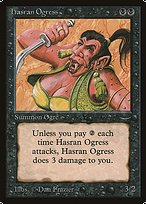










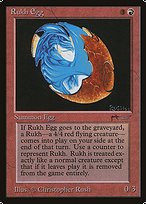





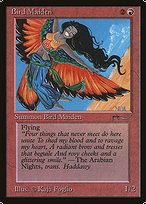
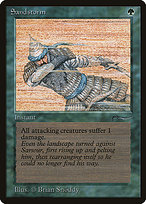









































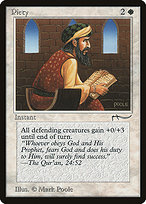





















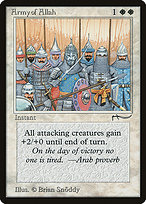










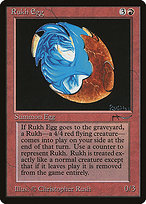

























Arabian Nights is a small set with 78 cards. Rarities of the cards vary according to the number of times they are printed on their sheets. The printing was done in Belgium.
Arabian Nights was sold in 8 card booster packs. Booster boxes had 60 packs.
Arabian Nights uses striped collation with 11 × 11 sheets. There are two print sheets: a common sheet and an uncommon sheet. Each pack gets 6 cards from the common sheet and 2 cards from the uncommon sheet. Packs can be either front-facing or back-facing and the uncommons can come before or after the commons.
| 6 Commons | 2 Uncommons |
| 2 Uncommons | 6 Commons |
Reconstructions of both sheets have been released by Charles Klein and Michael Cervenka. [1]
I have observed no instances of splitting on either sheet. Stripes are all width 3 and 4 except for one case of a width 5 stripe on the common sheet.
Due to technically difficulties, the bottom right six-by-six quadrant of the common sheet was created at an earlier time than the rest of the common sheet and the uncommon sheet. For everything but this quadrant, the mana symbols were changed. (It is also not a coincidence that the single basic land is in this quadrant.) [2] Hence, certain cards that appear on the common sheet both inside and outside this quadrant have two versions. The versions inside this quadrant have lighter mana symbols. This difference is most obvious for the generic mana symbol, but it is also detectable for the white and black mana symbols. At the time of writing, no one has confirmed any detectable difference for the blue, red, or green mana symbols (nor for the card Desert which has no mana symbol); so variants maybe only exist for those cards with colorless, white, and black symbols.
Many positions on the sheets may be distinguishable by printing dots or similar printing imperfections. With information about the sheet layouts, it should be possible to place many or all of these distinct versions of cards on the sheets, but this information is not yet complete. It appears as though some (perhaps all) of these imperfections arose during the creation of the quadrants, and thus similar imperfections appear at the same position in each quadrant across both sheets (when the quadrants are aligned at the bottom right corner). The most famous print dot is the "Mirage" or "Campfire" Desert which features a light spot a bit below the middle of the artwork for Desert. This print dot appears to be characteristic of cards that are, counting up from the bottom, in the sixth row, and, counting from the right, in the fifth column of each quadrant. Note that counting up to the sixth row will be off the edge of the sheet for the upper quadrants, so this print dot only appears in the lower two quadrants. For the common sheet, the affected cards are the two copies of Desert in the sixth row (hence there are two "Mirage"/"Campfire" Deserts), and on the uncommon sheet, the affected cards, again in the sixth row, are Jihad and Flying Carpet. [3]
27 different cards appear on this sheet. There are 16 cards that appear four times (C4), 9 cards that appear five times (C5) and one card (Desert) that appears eleven times (C11). The last card, Mountain, appears only once (C1) and could perhaps be classified as an uncommon (as it will have the same as-fan as a U3 card).
 |  |  |  |  |  |  |  |  |  |  |
 |  |  |  |  |  |  |  |  |  |  |
 |  |  |  |  |  |  |  |  |  |  |
 |  |  |  |  |  |  |  |  |  |  |
 |  |  |  |  |  |  |  |  |  |  |
 |  |  |  |  |  |  |  |  |  |  |
 |  |  |  |  |  |  |  |  |  |  |
 |  |  |  |  |  |  |  |  |  |  |
 |  |  |  |  |  |  |  |  |  |  |
 |  |  |  |  |  |  |  |  |  |  |
 |  |  |  |  |  |  |  |  |  |  |
| C1 Rarity |
|---|
| C4 Rarity |
| C5 Rarity |
| C11 Rarity |
As noted above, cards that appear in the bottom-right six-by-six quadrant and contain a generic, white, or black mana symbol are "light" variants (when contrasted with "dark" versions that appear outside this quadrant). The separate "dark" versus "light" rarities for these cards are listed below. Note that earlier sources often do not distinguish between the two versions of Camel [4] and also often incorrectly list "light" Moorish Cavalry as C1 (and hence the "dark" version as C4).
| Card | Dark | Light |
|---|---|---|
| Army of Allah | C3 | C1 |
| Bird Maiden | C2 | C2 |
| Camel | C3 | C2 |
| Erg Raiders | C3 | C2 |
| Fishliver Oil | C3 | C1 |
| Giant Tortoise | C3 | C1 |
| Hasran Ogress | C3 | C2 |
| Moorish Cavalry | C3 | C2 |
| Nafs Asp | C3 | C2 |
| Oubliette | C2 | C2 |
| Piety | C3 | C1 |
| Rukh Egg | C3 | C1 |
| Stone-Throwing Devils | C3 | C1 |
| War Elephant | C3 | C1 |
| Wyluli Wolf | C4 | C1 |
51 different cards appear on the sheet with 33 appearing twice (U2), 17 appearing three times (U3), and one, Oasis, appearing four times (U4).
 |  |  |  |  |  | 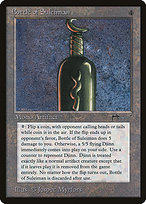 |  |  |  |  |
 |  |  | 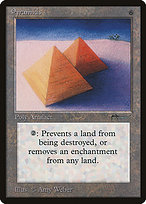 |  |  |  |  |  |  |  |
 |  |  |  |  |  | 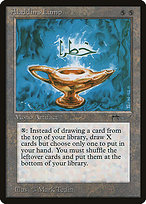 |  |  | 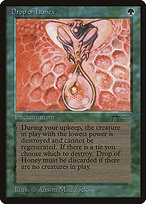 |  |
 |  | 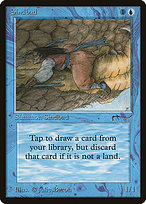 |  | 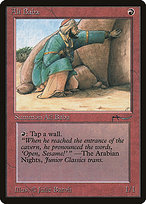 |  |  |  |  | 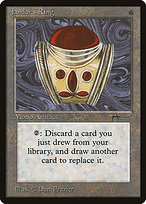 |  |
 |  |  | 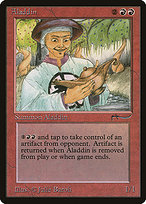 |  | 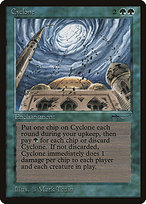 |  |  |  |  |  |
 |  |  |  | 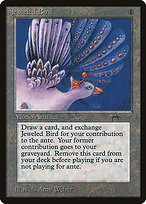 |  |  |  |  |  |  |
 |  |  |  |  |  |  |  |  |  |  |
 |  |  |  |  |  |  |  |  |  |  |
 |  |  |  |  |  |  |  |  |  |  |
 |  |  |  |  |  |  |  |  |  |  |
 |  |  |  |  |  |  |  |  |  |  |
[1] The announcement of the sheets' reconstruction was originally on facebook with an accompanying video available on Vimeo and Google Drive. The sheets plus supplemental information are also available from the Librarities thread.
[2] A first-hand account of the construction of the Arabian Nights sheets is given by David Howell in "Arabian Nightmare". This includes information about sheet quadrants (also mentioned in the Klein/Cervenka video), and the special circumstances surrounding the lower-right quadrant of the common sheet (and a specific reference to the Mountain).
[3] The Librarities thread lists information about print dots and other variations that have been identified. (At the time of writing, this work in ongoing, though not by me.) Correlation of print dots between different quadrants was proposed by Tavis King in that thread here. Also thanks to M.B. for contacting me with more information about Arabian Nights print variations.
[4] A specific reference to "light" versus "dark" Camel (with image reference) is provided in this Librarities post.